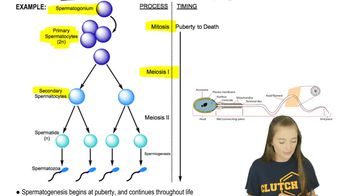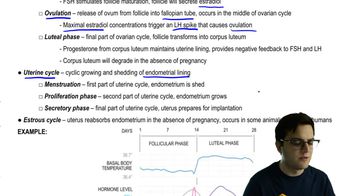Table of contents
- 1. Introduction to Biology2h 40m
- 2. Chemistry3h 40m
- 3. Water1h 26m
- 4. Biomolecules2h 23m
- 5. Cell Components2h 26m
- 6. The Membrane2h 31m
- 7. Energy and Metabolism2h 0m
- 8. Respiration2h 40m
- 9. Photosynthesis2h 49m
- 10. Cell Signaling59m
- 11. Cell Division2h 47m
- 12. Meiosis2h 0m
- 13. Mendelian Genetics4h 44m
- Introduction to Mendel's Experiments7m
- Genotype vs. Phenotype17m
- Punnett Squares13m
- Mendel's Experiments26m
- Mendel's Laws18m
- Monohybrid Crosses19m
- Test Crosses14m
- Dihybrid Crosses20m
- Punnett Square Probability26m
- Incomplete Dominance vs. Codominance20m
- Epistasis7m
- Non-Mendelian Genetics12m
- Pedigrees6m
- Autosomal Inheritance21m
- Sex-Linked Inheritance43m
- X-Inactivation9m
- 14. DNA Synthesis2h 27m
- 15. Gene Expression3h 20m
- 16. Regulation of Expression3h 31m
- Introduction to Regulation of Gene Expression13m
- Prokaryotic Gene Regulation via Operons27m
- The Lac Operon21m
- Glucose's Impact on Lac Operon25m
- The Trp Operon20m
- Review of the Lac Operon & Trp Operon11m
- Introduction to Eukaryotic Gene Regulation9m
- Eukaryotic Chromatin Modifications16m
- Eukaryotic Transcriptional Control22m
- Eukaryotic Post-Transcriptional Regulation28m
- Eukaryotic Post-Translational Regulation13m
- 17. Viruses37m
- 18. Biotechnology2h 58m
- 19. Genomics17m
- 20. Development1h 5m
- 21. Evolution3h 1m
- 22. Evolution of Populations3h 52m
- 23. Speciation1h 37m
- 24. History of Life on Earth2h 6m
- 25. Phylogeny2h 31m
- 26. Prokaryotes4h 59m
- 27. Protists1h 12m
- 28. Plants1h 22m
- 29. Fungi36m
- 30. Overview of Animals34m
- 31. Invertebrates1h 2m
- 32. Vertebrates50m
- 33. Plant Anatomy1h 3m
- 34. Vascular Plant Transport2m
- 35. Soil37m
- 36. Plant Reproduction47m
- 37. Plant Sensation and Response1h 9m
- 38. Animal Form and Function1h 19m
- 39. Digestive System10m
- 40. Circulatory System1h 57m
- 41. Immune System1h 12m
- 42. Osmoregulation and Excretion50m
- 43. Endocrine System4m
- 44. Animal Reproduction2m
- 45. Nervous System55m
- 46. Sensory Systems46m
- 47. Muscle Systems23m
- 48. Ecology3h 11m
- Introduction to Ecology20m
- Biogeography14m
- Earth's Climate Patterns50m
- Introduction to Terrestrial Biomes10m
- Terrestrial Biomes: Near Equator13m
- Terrestrial Biomes: Temperate Regions10m
- Terrestrial Biomes: Northern Regions15m
- Introduction to Aquatic Biomes27m
- Freshwater Aquatic Biomes14m
- Marine Aquatic Biomes13m
- 49. Animal Behavior28m
- 50. Population Ecology3h 41m
- Introduction to Population Ecology28m
- Population Sampling Methods23m
- Life History12m
- Population Demography17m
- Factors Limiting Population Growth14m
- Introduction to Population Growth Models22m
- Linear Population Growth6m
- Exponential Population Growth29m
- Logistic Population Growth32m
- r/K Selection10m
- The Human Population22m
- 51. Community Ecology2h 46m
- Introduction to Community Ecology2m
- Introduction to Community Interactions9m
- Community Interactions: Competition (-/-)38m
- Community Interactions: Exploitation (+/-)23m
- Community Interactions: Mutualism (+/+) & Commensalism (+/0)9m
- Community Structure35m
- Community Dynamics26m
- Geographic Impact on Communities21m
- 52. Ecosystems2h 36m
- 53. Conservation Biology24m
44. Animal Reproduction
Animal Reproduction
Problem 6`
Textbook Question
Many frogs and mice are similar in size, yet a frog egg is vastly larger than a mouse egg. Propose a plausible explanation for this difference in the egg size.
 Verified step by step guidance
Verified step by step guidance1
Understand the reproductive strategies: Frogs are external fertilizers, meaning they lay their eggs in water and fertilization occurs outside the female's body. Mice, on the other hand, are internal fertilizers with fertilization occurring inside the female's body.
Consider the survival rates: Since frog eggs are laid in water and are exposed to predators and environmental conditions, they are produced in large quantities with each being relatively large to house more yolk to sustain the embryo until it can fend for itself.
Analyze the development process: The larger size of frog eggs is also due to the need for more yolk to support the development of the embryo directly into a tadpole, which must be somewhat self-sufficient. In contrast, mouse embryos develop internally and are nourished directly by the mother through the placenta.
Examine the maternal investment: Mice invest in fewer eggs but provide prolonged internal protection and postnatal care, which increases the survival chance of each offspring. This allows mouse eggs to be smaller as the embryo relies less on the egg's initial yolk content.
Reflect on evolutionary adaptations: The differences in egg size between frogs and mice reflect their evolutionary adaptations to their respective environments and reproductive strategies, optimizing their survival and reproductive success.
 Verified video answer for a similar problem:
Verified video answer for a similar problem:This video solution was recommended by our tutors as helpful for the problem above
Video duration:
2mPlay a video:
Was this helpful?
Key Concepts
Here are the essential concepts you must grasp in order to answer the question correctly.
Oviparity vs. Viviparity
Oviparity refers to the reproductive strategy where organisms lay eggs that develop outside the mother's body, as seen in frogs. In contrast, viviparity involves live birth, typical of many mammals like mice. The differences in reproductive strategies can influence egg size, with oviparous species often producing larger eggs to provide sufficient nutrients for the developing embryo.
Recommended video:
Guided course

Dominant vs. Recessive Alleles
Nutritional Investment in Eggs
The size of an egg often correlates with the amount of yolk it contains, which serves as a nutrient source for the developing embryo. Frogs, which lay eggs in aquatic environments, produce larger eggs with more yolk to support the embryo during its early development stages, while mice, which give live birth, invest in fewer but more developed offspring.
Recommended video:
Guided course

Nutritional Diversity Among Microbes
Environmental Adaptations
Different species adapt their reproductive strategies based on environmental conditions. Frogs typically lay eggs in water, where larger eggs can help ensure survival against predation and environmental challenges. Mice, being terrestrial and nurturing their young internally, have evolved to produce smaller eggs that develop into more complex organisms before birth, reflecting their different ecological niches.
Recommended video:

Adaptive Radiation

 5:44m
5:44mWatch next
Master Sexual and Asexual Reproduction with a bite sized video explanation from Jason Amores Sumpter
Start learningRelated Videos
Related Practice



































































